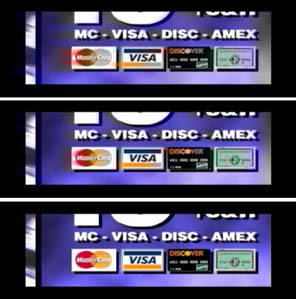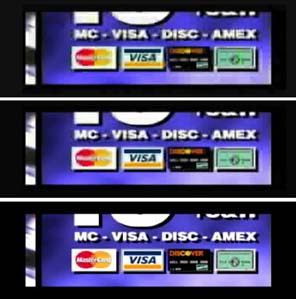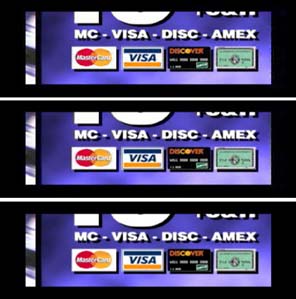|

|

|
DV
Compression Experiments
08/13/98
Running
an image through DV compression codecs
multiple times
by
Kent
Borg
<easiersaid@borg.org>
|
|
Wondering about how much my DV video will be
damaged with repeated compressions, I tried a
series of experiments. I started with a small TIFF
graphic which has been used in similar tests by
various people on the DV mailing list.
<www.DVCentral.org/thelist.html>
Certainly hard edged graphics are not what DV was
intended for--DV likes natural scenes far
better--but graphics do occur in television. I used
Adobe After Effects to make 15 generations of
recompression using each of three DV codecs:
- Radius
Soft DV NTSC (which came with Edit DV
1.1),
- Apple's DV
NTSC (part of Quicktime 3.0)
- Adaptec's
DV Soft (from Adaptec's Hot Connect driver for
their AHA-3945 SCSI/1394 combo card, downloaded
from their web site)
The first
thing I discovered is that this is not yet a mature
technology. First, the Radius codec doesn't like
Quicktime 3.0. Not only does it crush the contrast
with each generation, it also highjacks Apple's DV
codec preventing use of it. I have heard that there
is a fixed version of Radius' software, but I can
find no mention of it on their web
site. The
Radius codec does work with Quicktime 2.5, so these
tests were done under Quicktime 2.5. Second,
Apple's codec gives terrible quality images--at
least if you are so simple minded as to install
Quicktime 3.0 and double-click on a DV compressed
movie. The obscure solution was to find the
"Goodies" plug-in from my Quicktime 2.5 folder and
copy it to my Movie Player 3.0 folder, then do a
"Get Info" in Movie Player, adjust the popups to
read "Video Track" and "High Quality" and check the
"Enable High Quality Box". And do that for every DV
movie I want Movie Player (or After Effects) to
interpret in other than muddy-mode. (Jeeze! I
remember when the Mac was easy to use -- Is My Mom
expected to figure out this!?!) Note, this "High
Quality" option does not appear in Movie Player
2.5, so this is really obscure.
Third, the
Adaptec codec, which works under Quicktime 3.0,
seems to ignore the "High Quality" bit and simply
produces the same quality either way. It seems
unfortunate to ignore the setting, but heeding it
would be worse.
The results
showed up two important facts. First, there is
image degradation with repeated trips through the
DV codec. This seems obvious for a lossy codec, but
some others have thought otherwise. Second, all DV
codecs do not produce the same results. Though the
DV standard is precise about how DV data is to be
decompressed, there is latitude in how DV video is
compressed.
Who wins in
this test? Radius' DV codec clearly looks best if
you don't mind the blue halo off the right edge..
Second place depends on a judgement call. The
Adaptec DV codec has color smearing to the left,
more with each generation, but though Apple DV
codec has no color smear, it looks more out of
focus.
What does it
all mean?
First, what
you can see on a computer monitor is different from
what an NTSC TV monitor can show. And by the time
you consider what a VHS tape can show on your
average TV set these codecs will all pretty much
look the same. But don't give too much ground to
this argument, for things you might want to do in
post production, such as matting, will look
ugly--even at the VHS stage--if you start with
VHS-quality source material. It is always good to
stay as high quality as you can through out
production.
Second, there
is no sensible reason to ever run 15-generations of
DV compression in a real production. Unless you
want to remind people of the early days of desktop
publishing and the font crimes committed on early
Laserwriters, you mostly want to make simple cuts
from one shot to another, and cuts-only work
introduces no extra DV compression steps; for most
final frames your camera's original DV compression
might well make it out the master DV print with no
additional compression-related losses. For those
who can't resist making material that looks like a
nervous music video, think through your compression
path. Work uncompressed for intermediate renders,
or avoid intermediate renders by stacking all your
effects together at once.
Reduced (and
jpeg compressed) results are reproduced below.
Click on each strip to see the three examples at
actual size (also jpeg compressed). A Stuffit
archive of single frame DV movies, and the original
TIFF graphic, are also available: <gentest.sit
308K> I encourage you to look at these images on
your own NTSC monitor.

Adaptec 15, 8
and 1st generations (above top
to bottom)
Click to see actual size images

Apple 15, 8
and 1st generations (above top
to bottom)
Click to see actual size images

Radius 15, 8
and 1st generations (above top
to bottom)
Click to see actual size images
Copyright
1998, Kent Borg
Reprinted with permission
|